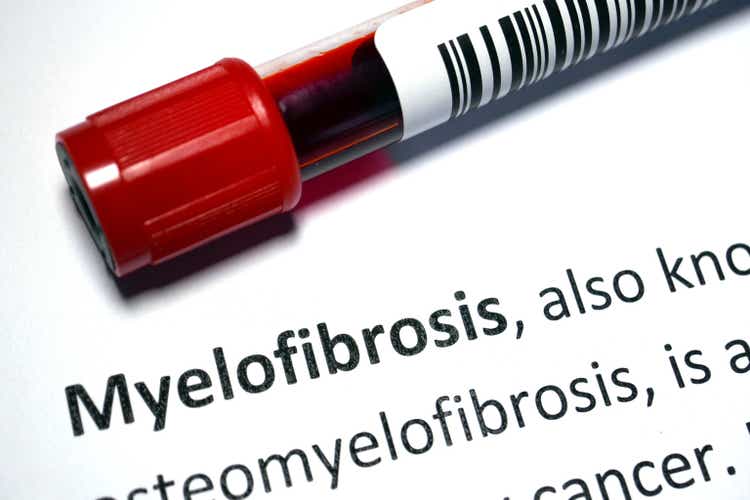Hailshadow/iStock via Getty Images
CTI BioPharma Corp. (NASDAQ:CTIC) is a small ($567 million cap) biopharmaceutical company focused on blood-related cancers. CTI has one FDA-approved product, VONJO (pacritinib), a Janus kinase (JAK) 2 and IRAK1 inhibitor, that spares JAK1. Inrebic, the competing JAK inhibitor from Bristol-Myers Squibb Company (BMY), turned in weak sales last week. VONJO has differentiated advantages that might help it pull ahead in sales numbers.
VONJO is indicated for the treatment of adults with intermediate- or high-risk primary or secondary (post-polycythemia vera or post-essential thrombocythemia) myelofibrosis (or MF) with a platelet count below 50 × 109/L. Approval was based on the pivotal Phase 3 PERSIST-2 study, with support from the Phase 2 PAC203 study. VONJO’s place in therapy has been expanded under the National Comprehensive Cancer Network (NCCN) Guidelines for Myeloproliferative Neoplasms. These are all category 2A recommendations, meaning there is a uniform NCCN consensus that the intervention is appropriate based upon lower-level evidence. All recommendations are category 2A unless otherwise indicated.
- VONJO is a second-line treatment (especially if platelet counts ˂50 X 109/L) for symptomatic lower-risk myelofibrosis, behind Jakafi (ruxolitinib)/Pegasys/hydroxyurea.
- For higher-risk non-transplant candidates, VONJO is the first choice (other than a clinical trial) for myelofibrosis patients with platelet counts ˂50 X 109/L,
- For higher-risk patients with platelet counts >50 X 109/L, VONJO is an alternate JAK inhibitor, behind Jakafi and Inrebic (fedratinib).
- Finally, for all those who had progression to advanced-phase disease/acute myeloid leukemia, VONJO is one of the JAK inhibitors that can be used in combination with hypomethylating agents (HMAs azacitidine or decitabine) for the palliation of splenomegaly or other disease-related symptoms. There are very limited data regarding the use of fedratinib or pacritinib with HMAs.
In short, VONJO will eventually be utilized in all MF patients with platelet counts ˂50 X 109/L. Above that threshold, VONJO will compete with Inrebic, but perhaps it won’t have to with certain patients who are initiated on Jakafi, the blockbuster ($2.1 billion sales in 2021) from Incyte Corporation (INCY). Jakafi has been the class’ MF standard of care for over a decade and its most common starting dose is 20 mg twice daily (or BID), in patients with platelets >200 X 109/L.
An article titled “Limited activity of fedratinib in myelofibrosis patients relapsed/refractory to ruxolitinib 20 mg twice daily or higher: A real-world experience” was E-published on May 25 in the influential British Journal of Haematology. This was a small retrospective study on 28 Mayo Clinic patients with MF relapsed/refractory (defined as lack of response or disease progression after a minimum of 3 months of therapy) to Jakafi. A notable finding was that:
“none of the patients on ruxolitinib ≥20 mg twice daily demonstrated a spleen response with fedratinib; moreover, pretreatment spleen size did not impact response (p = 0.48).”
This means VONJO is looking good as the salvage therapy of choice for higher Jakafi doses.
As for suboptimal doses, Jakafi treatment at a dose <20 mg BID at baseline, month 3, and month 6 was recognized as one of the 4 major risk factors that negatively impact overall survival in an article published online on March 17 in an American Society of Hematology journal. Since a low starting dose is based on low platelet counts, it’s extremely difficult to subsequently reach the 20 mg BID doses. This factor on the RR6 Calculator counts as 1 point towards the 2.5 points for placement in the high-risk group, which has a mortality hazard ratio of 8.37 (P < 0.0001) compared to the low-risk group (0 points). This research suggests that patients with platelets 50 to 200 X 109/L probably shouldn’t be started on Jakafi (limited to 5 or 15 mg BID starting doses), or if they are, switched very quickly to Inrebic or VONJO if non-responsive, and this population will be the latter two’s main battleground.
A 2021 American Journal of Hematology update still cites Jakafi’s high treatment discontinuation rate (“92% after a median time of 9.2 months“). Meanwhile, Inrebic has a black box warning for Wernicke encephalopathy and requires regular monitoring of thiamine levels. In a possible sign of things to come, U.S. Q3 sales of Inrebic were $17 million, a 15% decline from 2021’s $20 million. It is also a come-down from last quarter’s $20 million.
Inrebic’s slowdown doesn’t necessarily mean the MF market has been saturated. Jakafi had a surprisingly strong quarter, raking in $619.6 million (+13% YOY), showing that its time at the top isn’t nearing the end. Nevertheless, Jakafi isn’t for everyone; non-responsive patients have to go somewhere quickly, and if not to Inrebic, then it may well be to VONJO. Breakout sales of $20 million is not out of the question. This would represent a 62% increase from the $12.3 million in Q2, which caused a 12% CTIC price drop.
Despite an SEC-mandated exclusion of a portion of future sales, management claims their cash, which stood at $95.9 million as of June 30, could fund operations for at least one year. It’s reasonable, given that Q2 net loss was $22.7 million and some expenses tied to the launch could be non-recurring, but any extra sales will help extend the cash runway. The market might even be forgiving of anything above $15 million, considering Big Pharma BMY couldn’t do much better. If sales exceed $18 million, CTI BioPharma Corp. shares could easily revisit $6+.


Be the first to comment